
by hollyober | Oct 10, 2019
Insect pests can destroy substantial quantities of crops, prompting growers to invest heavily in pesticide use. Previ

These three common species of bats in FL, GA, and AL eat insect pests notorious for causing substantial damage to crops: the Seminole bat (Lasiurus seminolus), southeastern bat (Myotis austroriparius), and evening bat (Nycticeius humeralis) (photo credits @MerlinTuttle.org).
ous research in Texas suggested that bats could reduce pesticide costs by over a million dollars within their state, due to the bats’ fondness for pests that damage cotton. Scientists at UF/IFAS recently collected evidence locally that indicates bats are providing valuable assistance with pest reduction for many of the crops grown here too.
During spring and summer of 2018 scientists at UF clarified what the common species of bats were eating in north Florida, south Georgia, and south Alabama. We investigated 161 bats across 21 counties and found that 28% of these bats ate at least one Lepidopteran (moth) pest species, 21% ate a Coleopteran (beetle) pest, and 18% ate a Hemipteran (true bug) pest. In total, 12 different species of agricultural pest species were eaten by these bats.
The moth pests consumed by bats were:
- Green Cutworm Moth (Anicla infecta)
- Tobacco Budworm (Chloridea virescens)
- Soybean Looper (Chrysodeixis includens)
- Garden Tortrix (Clepsis peritana)
- Lesser Cornstalk Borer (Elasmopalpus lignosellus)
- Corn Earworm (Helicoverpa zea)
- Beet Armyworm (Spodoptera exigua)
- Fall Armyworm (Spodoptera frugiperda)
- Red-Necked Peanutworm Moth (Stegasta bosqueella)
The beetle and true bug pests consumed by bats were:
- Hairy Fungus Beetle (Typhaea stercorea)
- Tarnished Plant Bug (Lygus lineolaris)
- Two-lined Spittlebug (Prosapia bicincta)
Three of these pests (Soybean Looper, Beet Armyworm, and Two-lined Spittlebug) were most often consumed by pregnant and juvenile bats. This is good news for growers of crops affected by these pests because you have a sound option for increasing the likelihood of bats helping control them. The trick is to provide the conditions that adult female bats like near the crops these pests feed on (e.g., soybeans, peanut, cotton, corn, sorghum, safflower). Most female bats pick a maternity roost in early spring. A maternity roost is a structure that provides warm, dry, dark conditions for female bats to sleep in during the day, and it is ultimately where they give birth to pups. When selecting a site to set up a maternity roost, female bats look for structures that are large enough to provide shelter for a large number of bats. A roomy structure can accommodate many bats, which allows the flightless pups to keep each other warm while the mothers fly in search of food at night. Installing a bat house like those shown here can provide conditions appropriate for a maternity colony, increasing your chances of having bats help control these insect pests.
Another useful strategy for enhancing pest control services by bats involves creating or maintaining structures that could serve as natural roost sites for bats. The natural structures bats prefer include large trees with cavities, dead and dying trees with peeling bark, oak trees with Spanish moss, and palm trees allowed to maintain their dead fronds. In agricultural areas and suburban areas these types of trees are often in short supply.
Maintaining large, old trees of a mix of species, and supplementing with bat houses, can help ensure there are plenty of roosting options for bats. This, in turn, will increase the likelihood that bats are available to assist with your pest management.
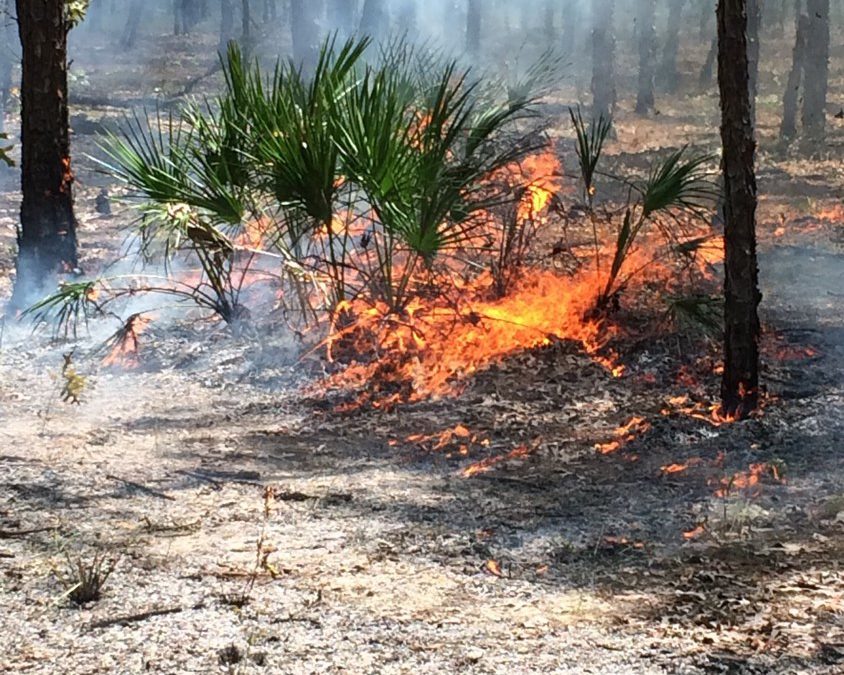
by hollyober | Mar 20, 2019
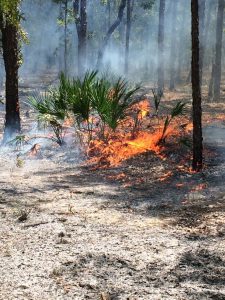
A prescribed fire burns safely in a natural area. Photo by Holly Ober.
Most plant and wildlife communities in Florida are adapted to periodic fires. For thousands of years, fires were ignited naturally, and frequently, by lightning. In fact, Florida has the greatest number of lightning strikes of any state in the country. About 1,000 lightning-set fires are documented in Florida each year.
Today, due to the many people living in Florida, the vast majority of fires naturally ignited by lightning are quickly suppressed by trained personnel. This is done to reduce the loss of human life and property. Although helpful to human safety in the short term, suppression of fire from natural areas for long periods of time can be problematic for all the native plant communities and wildlife that are adapted to periodic fire, and ultimately dangerous for humans as well. The longer our natural areas go unburned, the greater the accumulation of vegetative material that could serve as fuel for fire, and the greater the possibility of uncontrollable wildfires devastating natural areas, homes, and buildings when lightning strikes.
PRESCRIBED FIRES are an important tool: they are a safe alternative to wildfires. Prescribed fires are intentionally set under favorable weather conditions with the goal of stimulating the ecological benefits produced by natural wildfires. By selecting safe conditions for these burns and by preparing for them in advance by creating barriers to halt the spread of fire past desired borders, trained personnel have much more control over the results of these fires. The reason we often see and smell smoke in the spring is because this is the most popular time of year to use prescribed burning as a forest management tool.
Below are some of the benefits fire provides to the health of the many plants and wildlife that naturally occur in our state.
- Fire maintains required habitat conditions for many of Florida’s plant and wildlife species.
- Fire promotes fruit production of many woody plant species.
- Fire promotes flowering of herbaceous (non-woody) plant species.
- Fire promotes diverse herbaceous plants that serve as food for insects and wildlife.
- Fire scarifies seeds, breaking down their hard seed coats and promoting germination.
- Fire prepares sites for seeding or planting of species that require bare mineral soil.
- Fire creates growing conditions required by some cone-bearing trees. It reduces leaf litter on the soil surface, increases nutrient reserves, and canopy openings so that sunlight can reach the forest floor.
- Fire releases nutrients bound up in dead organic matter, ultimately increasing palatability, digestibility, and nutritional value of growing plants for wildlife.
- Fire can improve the quality of forage for grazing livestock.
- Fire changes the density of trees in the forest, creating space for some wildlife species.
- Fire removes hardwood thickets and vines in the understory of pine forests, making these areas more suitable for some wildlife species.
- Fire controls insect pests and diseases that afflict pine trees.
- Fire increases the rate of nutrient cycling of some elements and elevates soil pH.
- Fire creates a diverse habitat conditions when fires are patchy, leaving pockets of unburned areas.
- Fire reduces the risk of severe, high intensity wildfires that could cause harm to native plants and wildlife by preventing the accumulation of highly-flammable, dead vegetation.
The last week in January has been designated as Prescribed Fire Awareness Week in Florida. Early February has been designated as Prescribed Fire Awareness Week in Georgia. March is Prescribed Fire Awareness Month in South Carolina. Why are so many southern states making a big deal about prescribed fire? It is because we have recognized the importance of safe fires for both the health of our native plants and wildlife as well as the safety of our human residents and visitors. If you see or smell smoke in a nearby natural area, it might well be coming from a prescribed fire intended to benefit our natural plants and wildlife as well as our safety.
To learn more about prescribed burning in Florida, visit https://www.freshfromflorida.com/Divisions-Offices/Florida-Forest-Service/Wildland-Fire/Prescribed-Fire
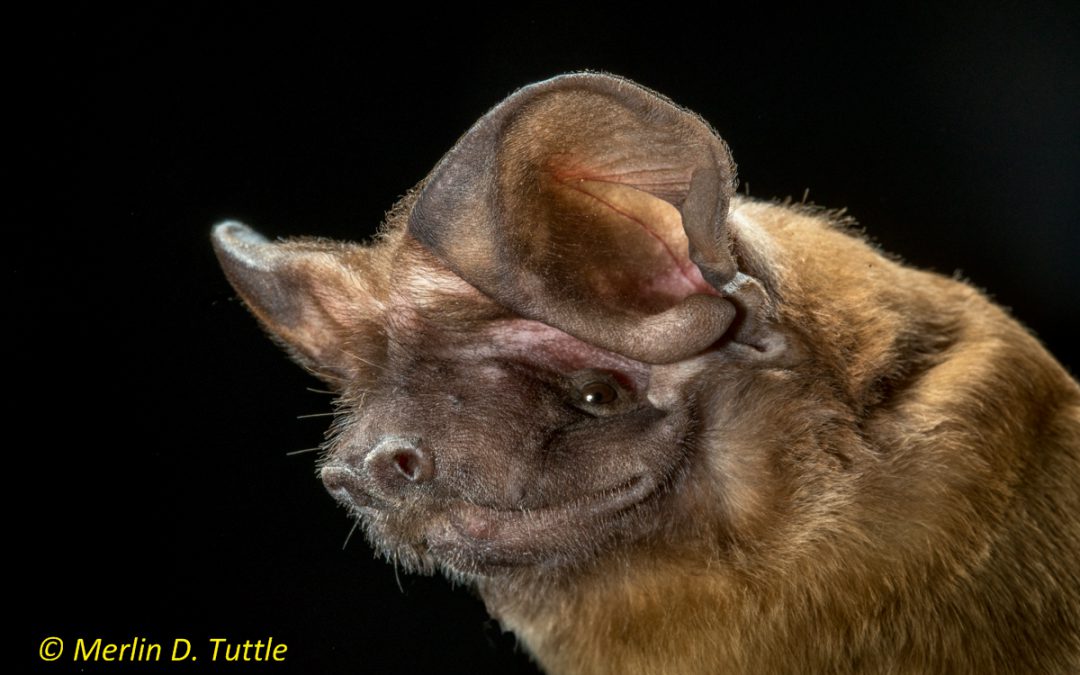
by hollyober | Nov 9, 2018
The week prior to Halloween is officially designated as National Bat Week. In honor of this event, it’s worth considering some of the benefits bats provide to us.
Did you know there is a species of bat that lives nowhere in the world but within our state? It’s called the Florida Bonneted Bat, and occurs in only about 12-15 counties in south and central FL. These bats are so mysterious that we’re currently not even sure exactly where they occur. They are so rare that they’re listed as a federally endangered species.
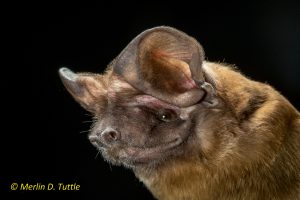
The Florida Bonneted Bat lives nowhere in the world but Florida. Photo credits: Merlin Tuttle.
These bats were named for their forward-leaning ears, which they can tilt forward to cover their eyes. With a wingspan of 20 inches, they are the largest bats east of the Mississippi River: only two U.S. species are larger than they are, and these both occur out west.
We have been investigating the diet of Florida Bonneted Bats. To do this, we captured bats in specialized nets, and then collected their scat (called guano). Next, we processed the scat in a laboratory using DNA metabarcoding to determine which insect species the bats had recently consumed.
We found that the bats eat several economically important insects, including the following:
- fall armyworm (Spodoptera frugiperda)
- lesser cornstalk borer (Elasmopalpus lignosellus)
- tobacco hornworm (Manduca sexta)
- black cutworm (Agrotis ipsilon)
These insects are pests of corn, cotton, peanut, soybean, sorghum, tobacco, tomato, potato, and many other crops.
Furthermore, the bats did not eat these insect pests infrequently. In fact, 86% of the samples we examined contained at least one pest species. On average, each sample contained three pest species! This tells us that Florida Bonneted Bats should be considered IPM (Integrated Pest Management) agents.
Currently, a new student has begun investigating the diets of bats more commonly found in northern Florida, southern Georgia, and southern Alabama. By the time Bat Week 2019 rolls around we’ll have details on which insect pests these bats could eat on your property.
If you’re interested in helping bats or incorporating them into your Integrated Pest Management efforts, consider creating roosts for them (places where the bats can sleep during the day). Bats roost not only in caves, but also in cavities in trees, in dead palm fronds, and in bat houses.

by hollyober | Mar 18, 2018
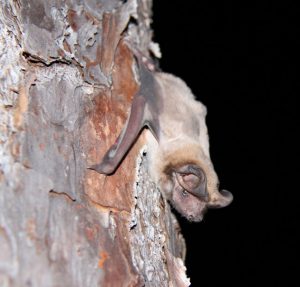
Bats sometimes move into buildings when they can’t find the natural structures they prefer (caves and large trees with cavities).
All 13 species of bats that live in Florida sleep during the day and feed on insects throughout the night. Most of these bats sleep in natural structures such as trees and caves. But when the natural structures these bats prefer are limited or vandalized, the bats may move into buildings.
Bats are a great help to us. Each of them consumes hundreds of insects per night. Bats save growers billions of dollars annually by reducing insect pests. Some of the pests bats feed on include the damaging fall armyworm, cabbage looper, corn earworm, tobacco budworm, hickory shuckworm, and pecan nut casebearer. But both bats and humans are happier when not sharing living spaces!
If you or someone you know has a group of bats living in a building where they are not welcome, you have options. The safe, humane, effective way to coax a colony of bats out of a building permanently is through a process called an ‘exclusion’. A bat exclusion is a process that prevents bats from returning to a building once they have exited at sunset to feed. This is accomplished by installing a temporary one-way door. This one-way door can take many forms, but the most common is a sheet of plastic mesh screening (with small mesh size of 0.125 x 0.125 inches or less) attached at the top and along both sides of the sheet, and open on the bottom. Another option is to install slick tubes (such as clean caulk tubes) to such entry points. These temporary one-way doors should be attached over each one of the suspected entry/exit points bats are using to get in and out of the building.
It is illegal to harm or kill bats in Florida. However, excluding bats from a building is allowed if you follow practices recommended by the Florida Fish and Wildlife Conservation Commission (FWC). According to Florida law, all bat exclusion devices must be left in place for a MINIMUM of 4 consecutive nights with temperatures above 50⁰ F before each entry point can be permanently sealed to prevent bat re-entry. Also, it is unlawful in Florida to attempt to exclude bats from a building between April 15 and August 15, which is bat maternity season. This is when female bats form large colonies and raise young that are unable to fly for their first few weeks of life. If bats were excluded during this time period, young bats (pups) would die indoors.
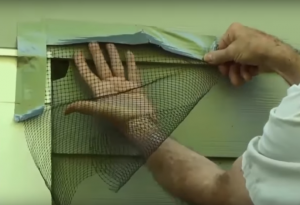
Bats can be coaxed to leave a building by first identifying the bat’s entry points into the building, and then creating a temporary one-way door using plastic screening with fine mesh size over each of these entry points.
The steps for an effective exclusion are as follows:
- Identify the locations where bats are getting in and out of the building. Look for holes or crevices about the width of your thumb, often near the roofline, with brown staining on the exterior of the building and bat scat (guano, about the size of a grain of rice and brown in color) below.
- Fashion and install one-way doors at each suspected bat entry point. This can be done anytime between August 16 and April 14 – it cannot be done when bats have young pups, which is between April 15 and August 15.
- Leave all one-way doors in place for at least 4 consecutive nights with minimum temperatures above 50⁰ F so all bats leave through the doors and cannot re-enter. If any one-way door becomes ineffective during the 4 day period, begin again. You must be absolutely certain all bats have exited so you do not block any inside the building.
- Immediately after removing the one-way doors, permanently seal each hole to prevent bats from getting back inside.
For detailed instructions on how to conduct a bat exclusion, see this video that features interviews with bat biologists from the University of Florida, FWC, and the Florida Bat Conservancy: How to Get Bats out of a Building.
For additional information on Florida’s bats, visit University of Florida’s bat advice or FWC’s bat website.
Remember, if you have a colony of bats roosting indoors that you want to exclude, you must either act within the next few weeks or else wait until the middle of August to coax them out. Bat maternity season in Florida runs from April 15 to August 15, and during this time no one can attempt to exclude bats from a building.
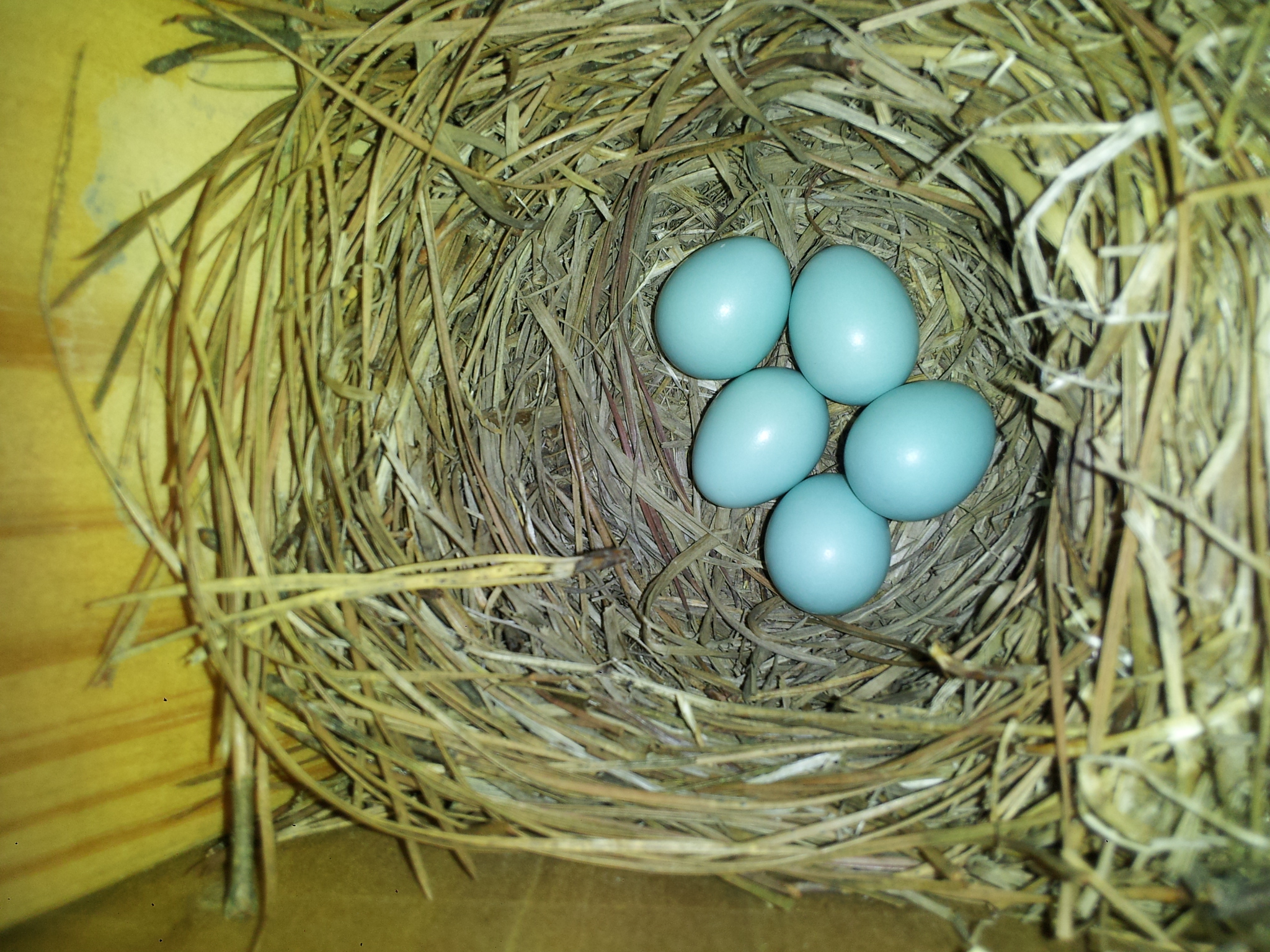
by hollyober | Mar 17, 2017
Bluebirds are very energetic birds. If you enjoy watching wildlife in your yard, now is a fantastic time to put up a few bluebird houses. You might gain hours of entertainment watching all the hard work these small birds put into gathering materials to build nests and gather food to feed their chicks.
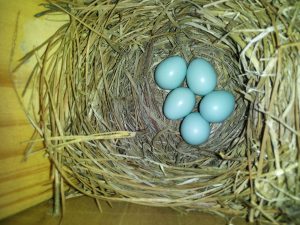
In the Panhandle, bluebirds begin in March to create their first nests of the year. They carefully weave a basket of pine needles and twigs, and line it with fine grasses. Photo by Holly Ober.
March is when bluebird nest-building begins in the Panhandle. Believe it or not, these enterprising birds are likely to continue building nest after nest from now through July or even August!
The reason we can observe bluebirds more closely than many other birds is because they prefer to nest in cavities situated in open, sunny locations. These birds readily use nest boxes because natural cavities in clearings are quite scarce.
If you’re considering putting up a nest box to attract bluebirds, be aware that these birds are rather fussy when it comes to selecting nest boxes. They prefer structures that are approximately 4”x4”x9” or 5”x5”x9”. These structures could be rectangular, cylindrical, or wedge-shaped. It’s best if the entrance hole is 1.5” in diameter, and located about 5” above the floor of the box. Each house should be mounted on a pole 4-8’ above the ground.
We have been conducting an experiment the past few years to determine which of three common nest box designs local bluebirds prefer. The three types of houses we tested were:
- traditional wooden rectangular house (4”x4”x9”)
- Gilbertson (cylindrical houses made of a PVC tube with a wooden floor and roof)
- Peterson (wedge-shaped houses made of wood and covered in metal, with a sloping floor and roof).
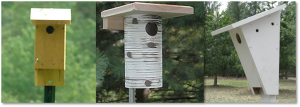
We tested bluebird preferences for 3 types of houses: the traditional rectangular wooden house (left), the Gilbertson (cylindrical house of PVC, center), and Peterson (wooden wedge-shaped, right).
We put up 18 houses during the summer of 2013 and have been keeping track of the number of nest attempts, eggs laid, and chicks fledged ever since. The ambitious birds using these 18 houses have fledged 124 chicks during the past three years! The standard rectangular wooden houses have performed best, with bluebirds laying an average of 8.3 eggs per house per year, and fledging 4.3 chicks per house per year. The other two house types performed similarly, with bluebirds laying an average of 4.3 eggs per house per year in each. An average of 2.4 chicks fledged from each of the Gilbertson houses each year, whereas 1.8 chicks fledged from each of the Peterson houses each year.
Regardless of which type of house you choose to put up for bluebirds, be sure to place the houses at least 100 yards apart. These birds are very territorial and will not allow other bluebirds to nest nearby.












